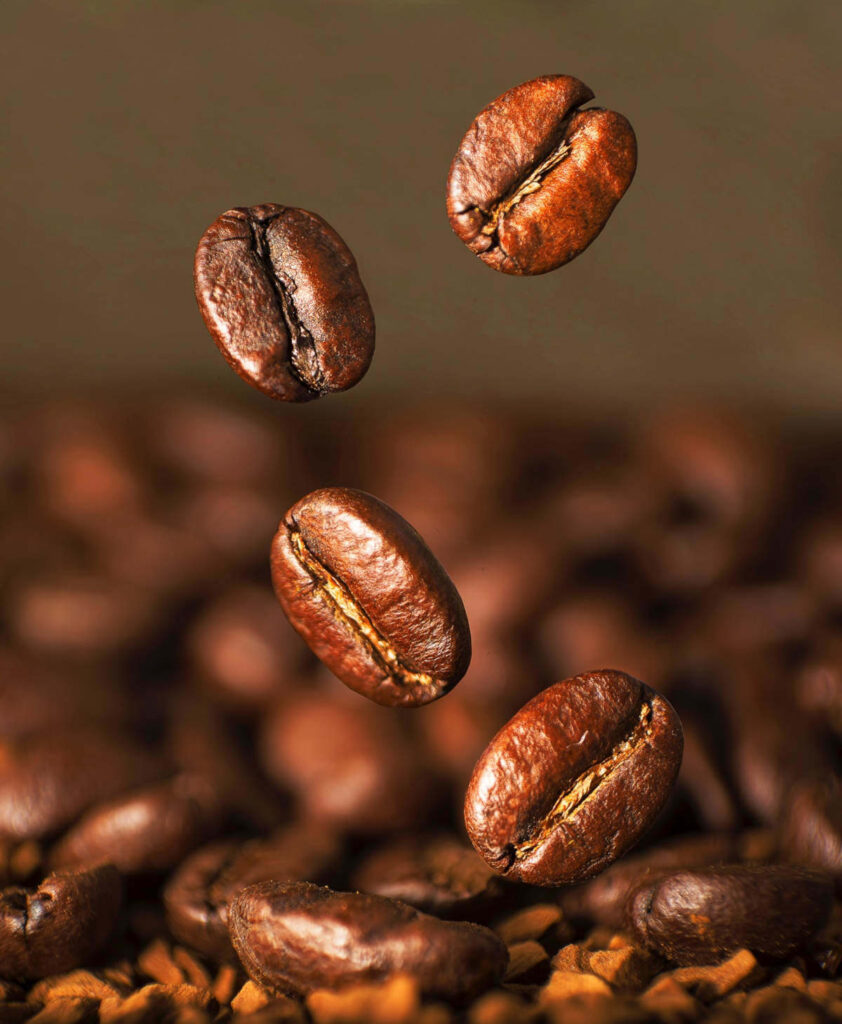What is arabica coffee?
Arabica coffee (species name is: coffea arabica) is a variety of coffee grown commercially and prized for its superior aromas and flavor.
The majority (more than 70%) of coffee grown around the world is arabica, with the remainder of commercially grown coffee mainly made up of lower quality robusta coffee beans.
Where does arabica coffee come from?
You may have heard the mythical story dating from around 1,100 years ago. Its about an Ethiopian goat herdsman noticing how lively his goats became after eating the berries of a certain plant. On eating the beans himself, the herdsman enjoyed a similar lift in energy.
Whether it’s true, even in part, at some point man became aware of the beneficial effects of consuming coffee.
We don’t know precisely how once wild-growing coffee plants came to be cultivated. It is known that coffee beans were being roasted, ground and brewed around 1,100 years ago. That started in Yemen in the Arabian Peninsula around 1,100 years ago. This coffee, which came to be known as arabica, has since spread around the world.
Arabica plant or tree?
Although we normally talk about coffee plants, they are actually trees. To make it easier to tend and to pick the ripe berries, farmers prune down their coffee trees. These shrub sized trees are therefore called coffee plants.
The arabica coffee plant grows best in a tropical climate – between the tropic of Capricorn to the south and the tropic of cancer to the north. The tropical climate provides the necessary heat to ripen the coffee berries.
It’s almost invariably cultivated at high altitude so that the coffee beans mature more slowly. The slower the berry grows, the more flavor it imparts to the coffee bean.
To get the best coffee beans, coffee trees need an area with high rainfall. And planted in mineral rich soils, such as volcanic soil.
To learn more about growing arabica coffee trees check out my post about geisha coffee. It is grown in ideal conditions.
Arabica vs Robusta which is best?
Arabica and robusta are the two most commonly grown coffee plants in the world.
It used to be thought that they were different species of coffee plant. However, recent research (mainly at Kew Gardens in London, England) has found that arabica is a descendent of robusta.
Whilst a common heritage accounts for the similarities between the species, it is in the differences that enjoyment and money are found.
Arabica is considered to be of superior quality to robusta, with pleasing aromas and flavors. Most people consider robusta coffee has less pleasant aromas and flavors.
Coffee experts often talk about arabica coffees as having a quality of citrus, fruity or even chocolate aromas and taste. Robusta coffee has a harsh and bitter taste with an aroma often compared to rubber tires or damp cardboard.
But there is a much simpler way to spot the difference. Brew some instant coffee and compare it to your experience of the best smelling and tasting coffee you have had. It doesn’t matter whether you brewed it at home, or drank at your favorite coffee shop.
You will notice the instant coffee doesn’t smell or taste as good.
The difference is, most instant coffee is made with 100% robusta coffee beans. While most coffees you grind yourself are made with up to 100% arabica coffee beans..
100% arabica coffee
Many coffee sellers boldly state their coffee is 100% arabica coffee, but what does it mean?
Arabica tastes and smells good, so by advertising coffee as 100% arabica, the seller is telling us its selling good coffee.
But that is not the end of the story. Being 100% arabica does not mean it’s all from the same exact beans. In fact, most coffees are blends of beans from a variety of sources.
So, for example, the winning coffee in the prestigious Best of Panama competition in 2021 was, nuguo fermented, grown on a tiny five hectare farm. And it sold at auction for $2,568 a pound.
Within that five hectare farm there are six separate growing areas with slightly different growing conditions. Each producing slightly different results. So the critically acclaimed and most expensive coffee in the world is actually a blend.
Coffee sellers also blend different arabica coffees from different places to get the desired qualities into the final brew. They may combine coffees with great aroma with others known for flavor to achieve a better final product.
What is so special about Arabica coffee?
As we know, arabica coffee smells and tastes better than its most common rival, robusta coffee. Arabica coffees aromas include floral, citrus, chocolate, caramel and honey. Combine that with flavors that range from citrus through sweet berries to chocolate and you have an idea why arabica coffee is so special.
To get the best from arabica coffee plants they need ideal conditions. These include, high altitude, a tropical climate, plenty of rainfall but must not be exposed to too much direct sunlight.
That means there are only a few places around the world that can grow arabica coffee beans. Those places include Central and parts of South America, South East Asia, China and some Caribbean islands
Arabica plants are also less resistant to pests and diseases such as coffee leaf rust. So producing a good high quality crop is more expensive.
So the majority of coffee farmed is arabica coffee. But its desirability creates a greater demand combined with high costs of production, pushing up prices.
Is there more than one variety of arabica coffee?
There are very many varieties of arabica coffee, some are known and cultivated. But there are believed to be over 120 varieties growing wild. So you never know -the best may be yet to come.
For a deeper dive check out the main varieties:
The most commonly cultivated varieties of arabica
Typica
Typica is believed to be the earliest cultivated varietal of arabica coffee.
Bourbon
The Bourbon coffee plant produces more coffee beans than Typica plants, with a distinct sweetness in flavor.
Mundo Novo
Mundo Novo is a naturally-occurring cross between Typica and Bourbon. It retains the aroma and flavor but produces a larger crop of coffee beans.
Caturra
Caturra is a naturally modified version of Bourbon. It’s capable of producing very large crops of coffee beans, but requires skilled management.
Geisha
Prized for its aromas and flavor, Geisha coffee beans are regular winners of major competitions and contributing to its very high price.
Pacamara
Pacamara is a hybrid varietal developed in the late 1950’s. It produces a good crop of very large, high quality beans with flavors of chocolate. However, it’s not a stable hybrid so different plants can have a variety of flavors, including an unpleasant herbal taste.
How to make Arabica coffee
OK I said this wouldn’t be a chemistry lesson. But you do need to know how to make coffee the way you like it. And repeat that process whenever, and wherever, you are.
If you haven’t made fresh ground coffee before, do not guess at the measurements. Start from a simple repeatable amount of coffee and water. That way you can repeat what works and adjust as needed. For a range of simple starter measurements take a look here.
If you have never made coffee from beans or fresh ground coffee, you will need some basic equipment.
Best Arabica coffee
For the very best experience of arabica coffee a number of things need to align. You need to start with the very best arabica beans. This does not mean spending $100’s a pound. Though at that price there are some amazing coffee beans being sold.
We have put together the following list of arabica coffee beans that offer a range of performance for your Dollar. You may want to use it as a tasting list – try buying (one at a time) a bag of each and keeping a note of how you brewed your coffee and the aroma and flavor. You will soon find you have favorites and preferences within the list.
Lavazza Caffe Espresso Italiano Whole Bean Coffee Blend, Medium Roast
Lavazza have been in the coffee business since 1859. In that time they have developed a range of highest quality coffees. The Lavazza Café Espresso can be bought as beans or ready ground (why do I need to go to the trouble of grinding my own beans?).
Starbucks Caffè Verona
Everyone has tried Starbucks coffee, so why not see if you can re-create the experience at home. If nothing else, you will learn how to vary your grind and brew, and the huge impact on aroma and flavor of doing that!
LifeBoost Coffee Medium Roast
Time to reach out a little and try an amazing coffee. The quality control at all stages ensures you receive the coffee beans that have been carefully selected and processed. The aromas and flavor are delicious. For a deep dive into Lifeboost coffee click here.
Copper Moon Sumatra Blend, Dark Roast Coffee
The last of our selections, the cheapest, but wow what a great coffee. It’s well worth the effort of grinding the beans!
So is Arabica coffee worth the effort?
Without doubt, arabica is the most widely grown and popular coffee around. There are some great varieties being cultivated, but with around 120 wild varieties there may well be some hidden gems waiting to be discovered and grown commercially.
but even with the varietals in cultivation, there is an arabica coffee for everyone. whether you like deep dark roasts of lighter more aromatic brews arabica has the coffee for you.
Hi, I’m Eric Loftuss, co-founder of Bean Thirst with my wife Sophie.
My Coffee journey started young. I used to help my mom with the weekly shopping trip and we always called in to a coffee wholesaler and retail outlet in our town.
I really started to learn about coffee when, while in college, I worked in a local coffee shop and trained as a barista. Even though I went on to qualify and work as a lawyer, I still get a kick out of brewing a cup of Joe.
Sophie and I are so glad to be part of your coffee journey. Find out more about us

